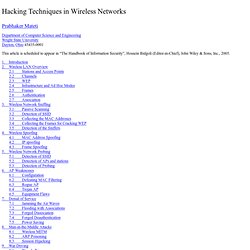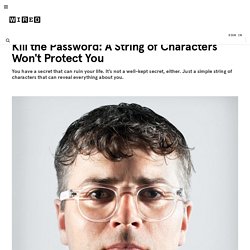

Hacking Wi-Fi Password (with good intentions) Using Ubuntu Linux. Hacking Wi-Fi Password Using Ubuntu Linux - I know a lot of you out there would love to know how to hack or crack Wi-Fi passwords from coffee shops or just about any place with managed or secured network.

Note: We do not encourage hacking on Wi-Fi networks without permission. Do it only for testing or for securing your own network. I've already featured several hacking software (and more hacking tools) before, and some of which can help you crack Wi-Fi passwords be it WEP or WPA protected. This time, I'm going to share with you some of my favorite wireless tools that can be used to hack Wi-Fi password using Ubuntu or any other Linux distribution: Aircrack-ngAircrack-ng (a fork of aircrack) is my main tool for cracking Wi-Fi passwords. Kismet Kismet is a really good network detector, packet sniffer, and intrusion detection system for 802.11 wireless LANs. SWScannerSWScanner is specifically designed to make the whole wardriving process a lot easier. Happy WiFi hacking. DShield; Cooperative Network Security Community - Internet Security.
SecTools.Org Top Network Security Tools. Hacking Techniques in Wireless Networks. Prabhaker Mateti Department of Computer Science and EngineeringWright State UniversityDayton, Ohio 45435-0001 This article is scheduled to appear in “The Handbook of Information Security”, Hossein Bidgoli (Editor-in-Chief), John Wiley & Sons, Inc., 2005. 1.

Introduction. 2 2. 2.1 Stations and Access Points. 3 2.2 Channels. 4 2.4 Infrastructure and Ad Hoc Modes. 4 2.5 Frames. 4 2.6 Authentication. 5 2.7 Association. 6 3. 3.1 Passive Scanning. 7 3.2 Detection of SSID.. 8 3.3 Collecting the MAC Addresses. 8. Kill the Password: Why a String of Characters Can't Protect Us Anymore. You have a secret that can ruin your life.

It’s not a well-kept secret, either. Just a simple string of characters—maybe six of them if you’re careless, 16 if you’re cautious—that can reveal everything about you. Your email. Your bank account. Your address and credit card number. No matter how complex, no matter how unique, your passwords can no longer protect you. Look around. This summer, hackers destroyed my entire digital life in the span of an hour. The age of the password is over.
Since that awful day, I’ve devoted myself to researching the world of online security. First thing I do? This summer I learned how to get into, well, everything. The common weakness in these hacks is the password. Passwords are as old as civilization. In 413 BC, at the height of the Peloponnesian War, the Athenian general Demosthenes landed in Sicily with 5,000 soldiers to assist in the attack on Syracusae. During the formative years of the web, as we all went online, passwords worked pretty well. How to Encrypt Your Internet Traffic. This is the coolest trick I learned while working at Blinkx.

At the time, our management really hated when we go on any type of instant messaging applications. I also suspected that our messenger conversations and other internet activities were being monitored. I was pissed so this is what I did to combat their nosiness. Open an SSH Tunnel to a Remote Machine There are a couple ways you can do this (one through Putty and one through Cygwin). Download and install Cygwin. That’s it! There are two ways to get this done. If you want to pay to do it the easy way, you can use programs like ProxyCap to handle all of your traffic routing.
Configuring Firefox to Use Your Tunnel Go to Tools > Options > Advanced (button) > Network (tab) > Connection > SettingsConfigure your Proxy settings like the image below: Click “OK” and you are set! Testing Firefox Proxy In the web browser, check that your IP is different from before you tunneled your traffic by using cmyip. Configuring AIM to Use Your Tunnel.